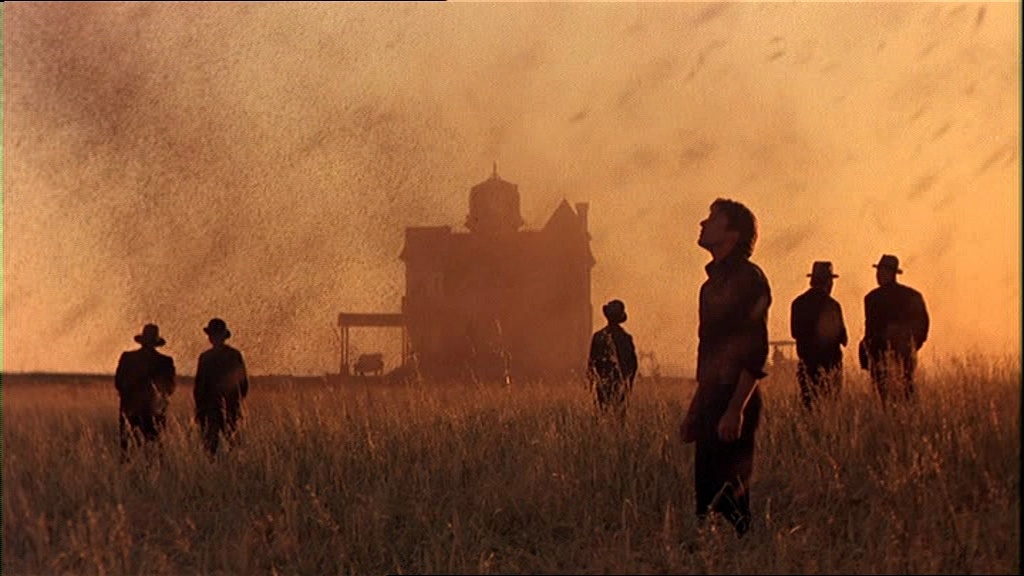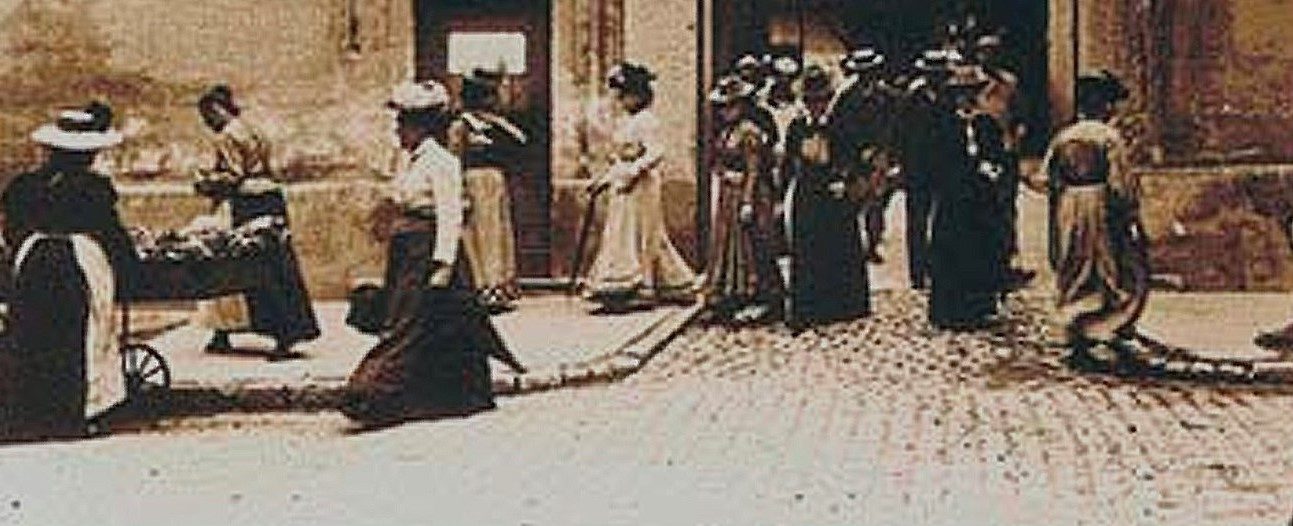United States, 1978
Directed by Terrence Malick
With Linda Manz (Linda), Richard Gere (Bill), Brooke Adams (Abby), Sam Shepard (the farmer), Robert J. Wilke (the foreman)

To enter the film is to come into what is a different country, just like the past is, according to Leslie Poles Hartley. The images are a long series of old photographs, portraits of folks from various ages but clearly from a lower class backgrounds. The camera zooms or glides as faces follow each others on the silver screen, adding up to a poignant collection, a multitude of workers and laborers whose eyes tell the moving, essential story of people struggling for life with pride. These gazes cannot leave the audience unconcerned, but truly hit them as those folks came to the country, hoped, and suffered to build their lives and a new nation.
The music is oddly, gracefully elegiac, a fluid melody of the clearest, purest notes evoking water and air, inviting to a harmonious, delicate world. This is “Aquarium”, one of the sections of the “Carnival of Animals” composed by Camille Saint-Saëns, which is arguably an astonishing artistic choice to illustrate these photos of American workers at the turn of the 20th century. It bolsters in an unexpectedly beautiful way the feeling of dignity emanating from the gazes, lends a troubling harmony to people who had to deal with harsh and upsetting working and living conditions, and puts the coming story under the sign of poetry and vision.
The sophomore feature of Terrence Malick navigates indeed between a realistic and tragic chronicle of folks trying hard to make a living and possibly to improve their lot and a breathtaking embrace of the American landscape where the battle takes place, between the relation of a sordid melodrama and the observation of the stream of life, both human and wild, and between the pain of people trying to enjoy the life they got and the vitality of a world they made. The director tackles with equal care and intelligence the torment of the individual experience and the collective effort, personal sentiments put under the line of fire and the exhilarating and bitter fight with the cosmos. His one hour and a half movie, whose narrative is relatively simple, is packed with strong emotions and striking visions, capturing skillfully and intensely the complexity of the American scene.
The narration is crafted around a double, puzzling movement too. The film is actually the memories of a character whose voice from time to time gives details and makes comments. This character is a girl, whose age is not given and is hard to ascertain with certainty: she seems to straddle the limit between the end of childhood and the blooming of adolescence. She does have reactions and use words redolent with child’s antics and dreams (that wish of her of being “a mud doctor”, what a word for the seemingly unattainable goal of becoming a scientist), but the times make her work as hard as any grown-up. And she expresses a clarity and lucidity about the ways and feelings of the adults she accompanies that is amazing, definitely relevant and clear-eyed and tinged with deep sympathy. The voice and attitudes of Linda embody both the liveliness and the optimism of youth while offering an honest, candid, realistic view of the world; she reflects acutely the energy of a young nation building itself, forging ahead in vast landscapes, bracing for the wild, enjoying modernity, but at the same time aware of the efforts and pains, thoughtful, and critical.
Linda’s tale is about a deception born out of rage. The first scene shows how restless, vindictive, eager for respect her elder brother Bill is. He argues with a foundry’s overseer and hits him. He runs away to the squalid place where Linda is making artificial flowers and Bill’s girlfriend Abby lies in a bed, sick. Bill decides on the spur of the moment they should leave Chicago and go west, trying their luck in agriculture. The three of them eventually stop in Texas’ Panhandle, hired like other traveling folks looking for any job as they stand on the top of trains rushing westward, in a big farm producing wheat.
Soon, Bill realizes Abby’s beauty has been spotted by the estate’s owner. By chance, he learns the farmer is sick, and perhaps months away from dying. So he convinces Abby to let herself be seduced in order to marry the wealthy man – the shocking, dishonest move would mean that she, Bill, and Linda would at long last make it. She reluctantly accepts and the love affair leads to a wedding strongly disapproved by the estate’s foreman, an old, tough fellow who is as much an avuncular, loving figure to the farmer as a loyal and demanding assistant. A few months later, things get out of control: Abby finds she is far more in love with the farmer than she thought it could be, the farmer seems in better shape than ever, and Bill grows impatient and jealous. Then the farmer gets suspicious. So Bill goes away.

When he comes back, nothing has changed, and the dream of living in the estate with his girlfriend is still elusive. The farmer gets even more suspicious and the relation ends in disaster at the same time locusts destroy the crops. By accident Bill kills the farmer, and he is once again forced to run away with Linda and Abby. But spurred by the aggrieved and stubborn foreman police chase them, and catch up with them. Bill is shot dead, Linda put in an institution, and Abby gets on a train full of soldiers drafted to go fighting in Europe – time is the late spring of 1917, America moves to uncharted territories, and the tale of Linda reaches a conclusion that is hard to guess, some two years after it started.
This is a poignant melodrama, prompted by the yearn for a better life which has thrown millions first on the sea, to reach America, and then on the streets of cities and on the roads and railways of the countryside. Bill wants badly to offer Abby, and also Linda, wealth and comfort, dismissing the ethics of work that yields in reality so little dollars but humiliates and exhausts so much, betting on death instead, manipulating the sentiments of others. But he is faced with a boomerang effect he never imagined: sentiments cannot be so easily faked, or conversely, easily sustained. One is always vulnerable, others are always demanding sincerity and truth, and all are bound to unhappiness, even if they are striving to avoid it, never absolutely bad but failing to be as good as possible (Linda’s lucid comments are remarkably sober). This is an American, and perhaps the one and truly American, tragedy: how a booming nation puts riches out of reach of many, how dreams fail to materialize, how the need for success becomes a dead end.
If the first scene hints at the troubles his temperament brings to Bill, the fall on the ground of the factory’s overseer heralding the collapse with a screwdriver of the farmer, it also visually sets the tone: the story constantly plays out with a fiery background and atmosphere. If basic natural elements matter a lot in the poetic approach of the plot, glow, flames, even explosions (from gunfire, for instance) are a defining and stupendous feature. Many a scene are shot at the so-called magic hour, the moment when daylight fades into dusk, before night set in, and the effect is indeed magical, a wonderfully warm vision of the world, highlighting the passions of humans, for better and worse. It is by dancing around a huge bonfire that the farmer and Abby officially start their relationship; it is as a fire sweeps the field, sparked by the lantern the farmer angrily throws at Bill, that the farmer evicts the cheating and lying wife, before trying to kill her real lover. The beauty of the world turns out to be tragically fleeting, as the same light that exposes it can leads to destruction: obviously, the film endlessly braces elements that are double, complex, ambiguous, even paradoxical, from the titles onwards.
Even as he was turning blind, veteran, great director of photography Néstor Almendros rises magnificently to the challenges crafted by the young director. His shots are an arresting visual splendor revealing a thrilling, and moving beauty, in the Texas landscape, while capturing the strong emotions running through the characters – in this regard, the moments Bill and Abby spends in a nearby river are truly poetic and delicate, water symbolizing the vivid, pure force of their love, the physical attraction and energy of the lovers, even as they draw up their deception and then try to live through it (here again, there is paradox, tension, trouble). The climax, both in the plot and the imagery, comes with the tragic night of the locusts and the crime. It is even more impressive and astonishing as there can no longer be any illusion, ambiguity, complexity: doom is here and inescapable, the dreadful and awaited moment when nothing can be saved and everything burns – and there is that fascinating image of clouds of locusts looking like clouds of smoke ascending from the ground as men stand up, still, and powerless beyond words.
The end chooses mystery: it is remarkably open-ended, as both Abby, first, and Linda, later, running away from the institution with a friend, get again on the move, rushing headlong to the unknown as they follow the railways, always with a smile on the face, taking the uncertain future in their stride (the last words of Linda’s voice are clear). They stand as stubborn, lively characters still ready to challenge fate, eager to move through the nation as they look for any opportunity, or adventure: the dynamism the film has observed and shared cannot be stopped, and the folks who got beaten and exploited as they build the nation cannot give up, their dreams and drive to live unassailable.
“Days of Heaven” goes deep into the psyche and the emotion of the director’s native country. The film explores the struggle for life and the conquest of the wild. It carefully observes the anxieties and desires of the individuals but never forgets to depict the wider community and the collective experience, whether it is the long travels by trains, the hard workdays in the fields, or the celebration of the end of the crop season, a most cheerful, dynamic moment in the film. Steeped into the political history as it happens, it is filled with key cultural references, from the visual arts (especially Edward Hopper) to jazz, and of course cinema: it is not only that the editing features flicks of Charles Chaplin, shooting is also reminiscent of the era (the first sequence, at the foundry, once again this scene, plays out exactly like a silent movie, without words and expressive gestures). What holds together and moves forward these elements and ambitions is a stunning poetic vision, that could be defined as a luminous harmony of the disharmony renting apart the characters and the nation, an elegy-like unity embracing and accepting to use jarring differences and high tensions. The success owes a lot to Malick’s magic ability to get the better from his collaborators, from an extended editing team to composer Ennio Morricone, and a superb cast (the gifted Linda Manz, the gorgeous Brooke Adams, Sam Shepard in one of his first big, and memorable, roles, Richard Gere in what is still is one of his most solid and moving performances, and old hand Robert J. Wilkes). Here is a genuinely great film from America, on America, for America.

